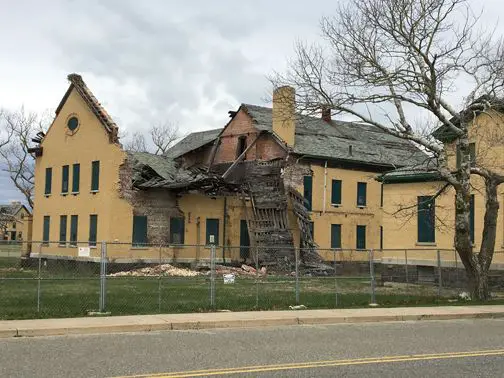It was May of 2019, more than five years ago, when it was announced there would be a festive groundbreaking the following month at MAST, the Marine Academy of Science and Technology at Sandy Hook.
The ceremony would take place before graduation at the buildings adjacent to Pershing Field, giving hope to those attending that graduation that in the not-too-distant future, students would at least have indoor space to conduct drills and marches during inclement weather.
The groundbreaking was scheduled to be a two phase program for abatement of hazardous materials, then intensive studies to determine the best and safest way to ensure stabilization of two more historic buildings at Fort Hancock.
There were plans for $14 millions to cover converting a small building and a former barracks into classrooms, drill space and storage area for MAST students, every one of them a cadet in the NJROTC.
Monmouth County and Monmouth County Vocational School administrators met with the National Park Service to report on the progress of Buildings 56, the small facility formerly a mess hall and 23, the former barracks.
Freeholder Lilian Burry had spearheaded all the activity, met with NPS Park officials on several occasions and envisioned cadets continuing their award and scholarship winning ways in enhanced settings that could better accommodate their needs.
She cited the benefits Monmouth County was providing, both in education and in historic preservation. The 21st Century Fort Hancock Advisory Committee endorsed the project as well, seeing preservation issues at the historic site enhanced by Monmouth County investments.
In May, with the ospreys returning, all officials knew that work on Building 23 could not begin until fall, since ospreys were nesting at the top of the lone wall still standing on the building and cannot be disturbed during nesting season. Work, however, could begin on Building 56.
The following month, as promised, groundbreaking ceremonies were held with national, county and local officials and guests present, along with the architect, Kellenyi Johnson Wagner.
Talks at the ceremony focused on the blend of history and the future, the expansion of the MAST program “cradling the growth of 21st century teens and beyond with a well-rounded education and deep knowledge and appreciation of American history.”
Construction was anticipated to be completed to enable use in September 2021.
That didn’t happen. Then the next year, nothing happened before it was osprey nesting season again. No construction. The former barracks sat untended, deteriorating,
Building 56 was rebuilt, for the most part completed, and put into use last year. It now housing more than 1,000 uniforms and naval equipment for the MAST cadets, replacing the crowded trailers that had been in place before.
Last year, bids were once again sought for construction of the building, the remaining wall held up with cranes. No ospreys.
Bids came in, as anticipated, over the $14 million that it was estimated to cost for construction pre-Covid days.
The bids were rejected .
Graduations have come and gone. Cadets who were there for the groundbreaking have completed college and some gone on to higher degrees, some to serve in the military, some to become professionals in other fields.
This year, the 61-cadet graduating class wrapped up more than $15 million in scholarships to prestigious colleges and military academies; some have already headed to their new sites of education, others are beginning to leave this week and next to build on everything they have learned at MAST.
Yet Building 23 remains untouched, with nothing to report on its future.
Buildings Buildings Buildings Buildings
Read More Stories About MAST HERE



